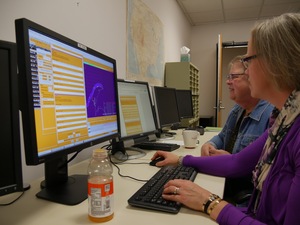GSD hosts forecasters to evaluate new Hazard Services Features

GSD researchers hosted more than a dozen participants for two types of tests of the Hazard Services system in July in the GSD Forecast Center. Hazard Services will modernize how National Weather Service (NWS) and National Centers for Environmental Prediciton (NCEP) create forecasts, watches, and warnings. The system provides a pathway to operations for promising science and technology to be more rapidly incorporated into the warning decision-making process. It is also the vehicle for bringing clear, direct language improvements into the watch/warning/advisory process to ensure more effective information is disseminated to the public.
The first test, known as a “Functional Forecaster Assessment Test” (FFAT), exposes forecasters to a new hazard workflow in an isolated system so they can focus on evaluating how Hazard Services creates watches/warnings/advisories and how the public would see these hazardous weather products. The FFAT will be evaluating long-duration marine hazards (such as gale, hurricane force winds, dense fog and smoke, freezing spray, and more) that mariners rely on when navigating open water. Forecasters will also evaluate non-precipitation hazards (such as extreme cold, excessive heat, dense fog and smoke, high winds, and volcanic ash) which can last for hours or even days and can affect vulnerable populations that do not have access to a safe, sturdy, and climate-controlled shelter.
The second test, a “System Functional Assessment Test” (SFAT) brings the Hazard Services workflow into a live system with real data to evaluate its performance in an operational-like environment. Researchers and developers want to know: Does it communicate well with the other software components? Are the hazardous weather products transmitted and stored successfully? The SFAT will be evaluating Phase 1 of the hydro hazard simplification deliverables which consolidates the number of flooding products issued by the NWS. The SFAT will also evaluate how the next-generation of winter weather watches, warnings, and advisories (including winter storm, blizzard, ice storm, freezing rain, and more) are created and issued in Hazard Services. Improving these workflows aligns with GSD’s mission to make forecasts better, particularly for high-impact events like winter storms that can cause billions of dollars in damage in only a few days. This will be the first-ever SFAT for Hazard Services hosted at GSD.
GSD is expecting 14 participants from outside of Boulder, CO: 7 are from WFOs, 3 from training division, 4 from national centers or offices. In addition, 10 GSD researchers will participate in these tests.
On April 18, 2019 a milestone was achieved with Hazard Services when the WFO Omaha (OAX) issued/ transmitted an operational river flood product from AWIPS Hazard Services. This was the first end-to-end test of this type for Hazard Services and the distribution was successful.
These tests are helping GSD prepare for the nation-wide deployment of Hazard Services with AWIPS 19.3.1 starting this October.
For more information contact: Susan Cobb 303-497-5093
